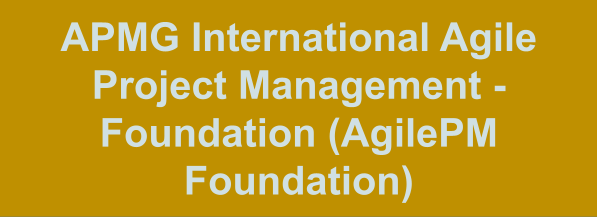Who is the Foundation Level for?
What are the key things you will learn?
AgilePM Foundation: APMG International Agile Project Management - Foundation
APMG International AgilePM Foundation Exam Summary:
| Exam Name | APMG International Agile Project Management - Foundation |
| Exam Code | AgilePM Foundation |
| Exam Fee | USD $330 |
| Exam Duration | 40 Minutes |
| Number of Questions | 50 |
| Passing Score | 50% |
| Format | Multiple Choice Questions |
| Books | Find a training provider |
| Sample Questions | APMG International AgilePM Foundation Level Exam Sample Questions and Answers |
| Practice Exam | APMG International Certified Agile Project Management - Foundation (AgilePM-Foundation) Practice Test |
APMG International Agile Project Management Foundation Syllabus Topics:
| Topic | Details |
| Lifecycle and Products | |
| Know facts, terms and concepts relating to the syllabus area. Specifically to recall: |
- What DSDM is and what the benefits of using DSDM are.
- The use of the Project Approach Questionnaire as a means of assessing the initial status of a project as an Instrumental Success Factor. |
| Understand how the LP theme is applied throughout the project lifecycle. Specifically to identify: |
- How the Pre-Project phase in the process adds value.
- The purpose and use of the Business products from each lifecycle phase:
- The purpose and use of the Solution products from each lifecycle phase:
- The purpose use of the Management products from each lifecycle phase:
- The purpose use of the Management products from each lifecycle phase:
- The purpose use of the Management products from each lifecycle phase:
- How the phases in the DSDM process help to build quality. |
| Be able to apply and tailor the relevant aspects of the LP theme to a project scenario when configuring the lifecycle and completing elements of major products. Specifically to: | |
| Be able to identify, analyse and distinguish between appropriate and inappropriate application of the LP theme to a project scenario. Specifically to analyse, with reasons: | |
| People and Roles | |
| Know facts, terms and concepts relating to the syllabus area. Specifically to recall: |
- The dimensions of the roles within an Agile Project Team and the names of the roles contained within each dimension:
- The purpose of each category group, and the names of the roles in each of the three role categories and how they can be used:
|
| Understand how the PR theme applies throughout the project life-cycle. Specifically to identify: |
- The definition and responsibilities of the Business Sponsor role.
- The definition and responsibilities of the Supporting roles:
|
| Be able to apply and tailor the relevant aspects of the PR theme to a project scenario. Specifically to: | |
| Be able to identify, analyse and distinguish between appropriate and inappropriate application of the PR theme to a project scenario. Specifically to analyse, with reasons: | |
| Techniques | |
| Know facts, terms and concepts relating to the syllabus area. Specifically to recall: |
- The definition of the MoSCoW technique and what the letters stand for.
|
| Understand how the TE theme applies throughout the project life-cycle. Specifically to identify: | - Key concepts in Facilitated Workshops, and how they add value throughout an Agile project. - The MoSCoW prioritisation rules. - How the MoSCoW prioritisation approach relates to a specific timeframe and how it adds value throughout an Agile project. - Key concepts in Iterative Development, and how it is planned and controlled throughout an Agile project. - How Iterative Development adds quality throughout an Agile project. - Key concepts in Modelling and how it adds value throughout an Agile project. - The key elements of the steps in a Structured Timebox. - The key elements of the steps in a Free Format Timebox. - The approach to Timeboxing, (including Daily Stand-ups), and how it adds value throughout an Agile project. |
| Be able to apply and tailor the relevant aspects of the TE theme to a project scenario-based situation. Specifically to: | |
| Be able to identify, analyse and distinguish between appropriate and inappropriate application of the TE theme to a project scenario. Specifically to analyse, with reasons: | |
| Planning and Control | |
| Know facts, terms and concepts relating to the syllabus area. Specifically to recall: |
- The key elements of the DSDM Philosophy.
- The definition of Principles 3–4:
- The title and definition of Principles 5-6:
- The definition of Principles 7-8:
|
| Understand how the PC theme applies throughout the project life-cycle. Specifically to identify: | - How the DSDM Principles are used and add value to an Agile project. - How tracking and control is used and adds value to an Agile project. - How Agile projects are planned and how planning adds value to an Agile project. |
| Be able to apply and tailor the relevant aspects of the PC theme to a project scenario. Specifically to: | |
| Be able to identify, analyse and distinguish between appropriate and inappropriate application of the PC theme to a project scenario. Specifically to analyse, with reasons: | |





0 comments:
Post a Comment